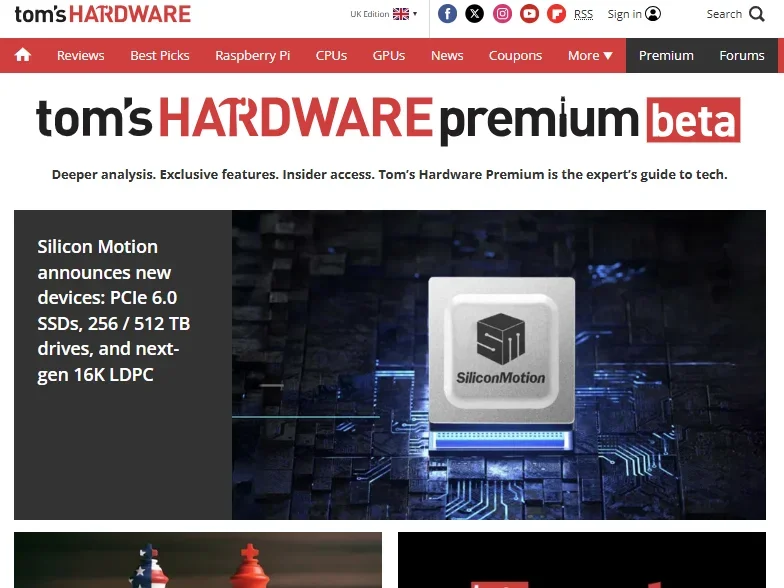
Future plc is testing a membership model on tech brand Tom’s Hardware in a significant expansion of its online paid content efforts.
Tom’s Hardware, which launched in 1996 and publishes news and reviews around the around the PC hardware and semiconductor industry, has introduced a premium membership described as being in beta testing.
The launch makes Tom’s Hardware one of only a handful of Future brands with a digital subscription product.
The membership includes exclusive paywalled content, a new subscriber newsletter, Q&A sessions with industry experts and access to Bench, a new tool based on its test results for central processors (CPUs), graphic cards (GPUs) and laptops.
Non-premium content remains free to read. Regular readers may see a window asking them to create a free account after viewing five articles, although this can be dismissed.
Future’s two-year growth acceleration strategy announced in December 2023 included plans to grow a “highly engaged and valuable audience” and “drive premium monetisation”.
It was also aiming to diversify and increase revenue per user with new ways of monetisation. Future has largely been reliant on advertising and e-commerce/affiliates amid the continued decline of its print magazines.
Since then Future has undergone a change of leadership, with chief executive Kevin Li Ying joining in March to succeed Jon Steinberg.
Tom’s Hardware tells readers it’s a ‘fair price’
Tom’s Hardware interim editor-in-chief Paul Alcorn told readers: “This service will ultimately enable us to invest more time in the painstaking analysis and data collection that define our brand, while also enabling us to expand the scope and depth of our coverage, bringing you along with us as we explore the latest and greatest in the industry.”
He described it as “an extension to what our website has done for years, and an expansion into new territory” with new types of content including “the story behind the story”.
Tom’s Hardware had an audience of 914,464 people in the UK in June, according to Ipsos iris, an increase of 39% compared to the month before.
Sister website Tom’s Guide, which has a more generalist remit of tech product and home reviews and streaming TV news and remains entirely free, has an audience that is more than twice as big, on 2.4 million in June.
The premium membership is priced at £51 per year, which was met with initial concern from some readers on its forum.
Sayem Ahmed, who joined Tom’s Hardware as subscription editor in February, posted in response: “We feel this is a fair price for the offering, considering the breadth of content, the new benchmark test visualization features, the specials we have planned and more.
“Note that this is just a beta… Tom’s Hardware is just getting started. We have loads of technical work to do behind the scenes, and we have many plans for future features, which is likely to include more pricing options down the line.”
A Q&A about the subscriptions tell readers that they will still see adverts even if they pay. “We want to offer you the best journalism possible. To do this, we fund our content through a mix of advertising, affiliate earnings, and now, subscriptions.
“This enables us to keep offering you best-in-class content, whether you are a free reader or a paid subscriber. As ever, advertisements will never affect what we, the Tom’s Hardware editorial team, choose to cover.”
The Q&A added that the premium offering “was created to give our most engaged readers more of what they value: deeper analysis, performance insights, and access to expert opinions. It supports the continued development of quality, well-researched content.”
Tom’s Hardware has previously been the site for experimentation at Future as it launched an AI chatbot based on its archive in May 2023 so readers could ask for specific recommendations and advice. The Hammerbot remains at the bottom of the Tom’s Hardware homepage although it is still described as a “test”.
Handful of premium content models on other Future plc brands
Of the around 43 brands owned by Future that have a website presence, Press Gazette counted only three others with a similar premium, part-paywalled offering and one with a harder paywall.
On the websites for most Future brands, the “subscribe” button takes people to a page to subscribe to the print, or print and digital, magazine.
Wine news and reviews site Decanter launched its own premium model with paywalled content in October 2017 and it currently costs £99 annually or £14 a month.
Cycling News shifted the number of premium-only articles on its own website “up a gear” in the last few months of 2024 and launched a subscriber-only newsletter.
Editor Peter Stuart told readers a Cycling News subscription means they get “unlimited access to all of Cyclingnews but it also helps support our journalism, allowing us to push the boundaries of our premium features – like our aero road bike helmet wind tunnel test – and ensure we’re at more races across the season than any other media outlet”.
Music industry title Music Week has online subscriber-only content, costing £165 for a year or £215 with the monthly print magazine.
Meanwhile, Future’s Horse & Hound magazine has a harder website paywall that appears to allow people to read five articles in a month before being prompted to pay. The digital subscription costs £87.99 per year or £7.99 monthly at full price.
In the year to 30 September 2024 Future’s revenue increased by 1% on an organic basis to £788.2m – but the growth was largely from insurance comparison site Go Compare.
The B2B division, which includes Music Week, fell 1% to £62m while the flagship B2C business fell 8% to £523m.
Email pged@pressgazette.co.uk to point out mistakes, provide story tips or send in a letter for publication on our "Letters Page" blog
